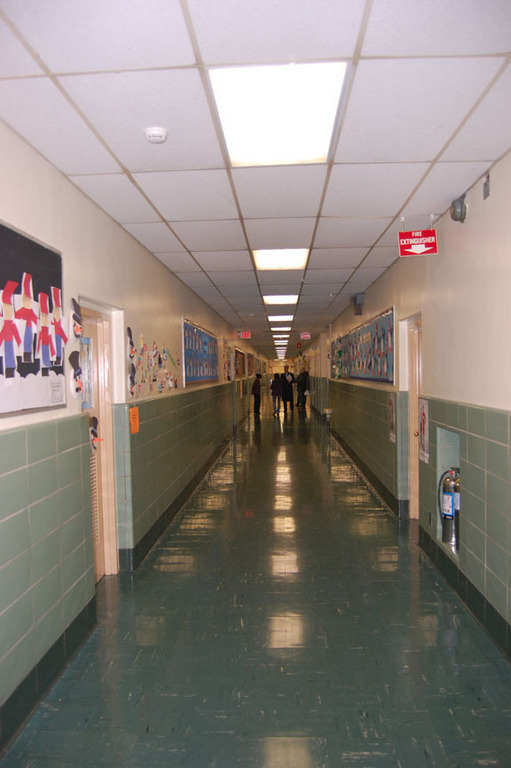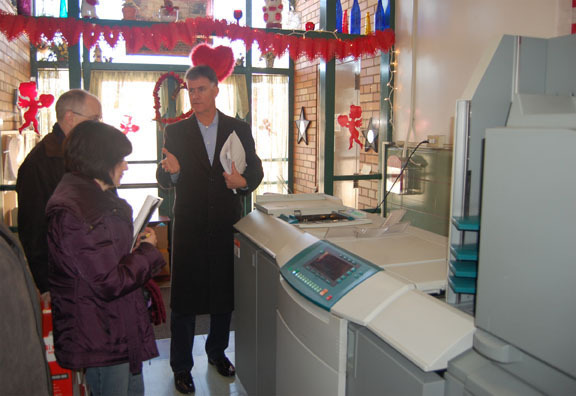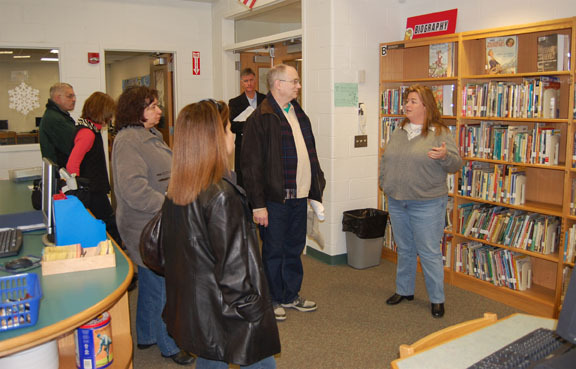Board takes building tour
Roofs, floors, security a priority for school officials
The roof at the Clear Stream Avenue School will be replaced this coming summer, one of a few projects planned in District 30.
Board of Education members and administrators toured the district’s four buildings last Saturday morning to see what other projects are on the horizon and what might need to be added to the list.
The entire roof at Clear Stream Avenue, with the exception of the 1998 addition, will be replaced at a cost of $507,000. This is part of a three-year, $2.8 million project to replace roofs throughout the district. Shaw Avenue was done this past summer and Forest Road in 2008.
Another major project this summer will be replacing original asbestos floor tiles in the 1956 wing at the Forest Road School and the 1950 wing at Shaw Avenue School. School board trustee Carolyn Pean asked why they were ripping out the old tile, which will be a much bigger project as an asbestos abatement, than just covering it over. Facilities director Greg Abbate said that the adhesive on the old tile is not permanent so if those come loose, that would be two layers of tile to replace.
He also noted that the water table at Forest Road is particularly high — it is just a few feet from the bottom of the school — so if water ever rose into the school, those old tiles would come right up. The principals at Forest Road and Shaw Avenue would have input as to the color scheme of the new tile.
Floor replacements would cost about $89,000.
District officials plan to upgrade the security system at several buildings. The video surveillance system at Forest Road School, which has eight cameras, was installed in 1999 and holds 72 hours of footage. Abbate said he would like to upgrade to a digital surveillance system there, as well as at the Washington Avenue Kindergarten Center.
The system at Shaw Avenue School has three cameras but was damaged during the fire over the summer. A new system will be installed there within the next few months and feature eight cameras.
A wireless clock system has been installed at Forest Road and Clear Stream Avenue, and will soon be done at Shaw Avenue, Abbate noted. Some masonry repairs are also needed at Clear Stream Avenue along with some sidewalk fixes.
Clear Stream Avenue School will soon be getting its own high-speed copier. Right now, high-volume copies such as classwork and the school newsletter have to be done at Shaw Avenue School. The copier there will be moved to a space in the computer lab at Clear Stream, and Shaw Avenue will get a new machine.
The stage curtains and window drapes at Forest Road and Clear Stream Avenue will be cleaned over the summer. The district will also have automatic hand-driers installed in bathrooms to replace paper towel dispensers. Bathroom stall partitions are also being replaced at the schools.
Some major projects down the road could include ceiling replacements at the Shaw Avenue School and window replacements throughout the district.
Ed Cullen, assistant superintendent for business, said the ceilings in the two classroom wings at Shaw Avenue School are starting to sag. He said these will eventually need to be replaced. New, energy-efficient lighting would be installed as part of that project. Cullen said that work will be recommended to the board to be included in a capital reserve proposition on the May ballot. If approved, the ceiling replacement would be done in the summer of 2011.
Another project that could be included in May’s capital reserve proposition is window replacements for Forest Road, Shaw Avenue and Clear Stream Avenue. The current windows were installed between 1982 and 1985. Abbate said this is a safety issue because if the window is open and the balance breaks, it could slam down. Also, replacements parts are no longer available.
His preference would be to have sliding windows put in, similar to what were installed in the 2003 additions at the schools.
Cullen said replacing windows throughout the district would cost about $1.3 million. “It’s a huge project,” he said. “It might have to be done in three or four phases.”

 61.0°,
Mostly Cloudy
61.0°,
Mostly Cloudy 











